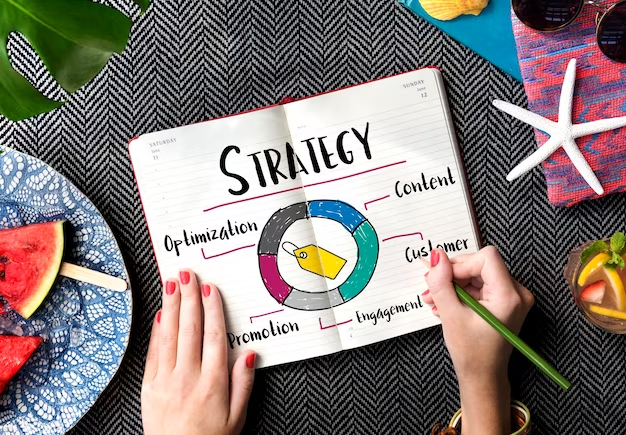A content strategy framework is a plan that guides you on how to create and optimize your website’s content. So that it can achieve your online goals and provide value to your audience.
A content strategy framework can help you align your content with your brand identity. Helping you create content resonating with your audience’s needs, preferences, and expectations. It can also help you improve your website’s performance and results. Such as ranking, traffic, conversions, and revenue.
In this article, we will explain what a strategy framework is and why it is important. We’ll also see how you can create one for your website.
What is a Content Strategy Framework?

It is a document that outlines the key elements and steps of your content strategy, such as:
- Content audit: This is the process of reviewing and analyzing your existing content. To identify its strengths, weaknesses, opportunities, and threats.
- Content goals: This is the process of defining and setting your content goals. Which are measurable outcomes that you want to achieve with your content.
- Content audience: This is the process of understanding your target audience. And understanding how you can provide value and solutions to them.
- Content topics: This is the process of finding and selecting the best topics for your content. Based on your niche, audience, and competitors. Topics are the main ideas or themes that your content covers. They should be relevant, interesting, and useful for your audience.
- Content types: This is the process of choosing the best types and formats for your content. Types and formats are the ways that you present and deliver your content. They should be suitable and effective for your content’s purpose and message.
- Content creation: This is the process of producing high-quality content for your audience. Your content should be original, relevant, informative, and entertaining. It should provide value and solutions to your audience’s needs and problems.
- Content optimization: This is the process of applying the best practices of SEO to your content. So that, it can rank higher on search engines and drive more organic traffic to your website.
Why is a Content Strategy Framework Important?
A content strategy framework is important for various reasons, such as:
- It can help you create and manage your content more effectively. It can provide you with a clear and structured plan and guide. Which can help you avoid any confusion, inconsistency, or duplication in your content.
- It can help you align your content with your brand identity, tone, and voice. Also helps you define and set your content goals.
- It can help you improve your website’s performance and results. Such as ranking, traffic, conversions, and revenue. As it can help you create and optimize your content for your target keywords and topics. And for your audience and search engines. It can also help you distribute and efficiently measure your content.
How to Create a Content Strategy Framework for Your Website?
Creating a content strategy framework for your website? You should follow these steps:
Conduct a Content Audit
The first step is to review and analyze your existing content. To identify its strengths, weaknesses, opportunities, and threats. You should use various tools and methods to collect and organize your content’s data.
You should also check your content’s quality, relevance, consistency, and effectiveness. Also how it matches your online goals and your audience’s needs. You should also discover and fix any content gaps, issues, or errors. Focus on them according to their importance and urgency.
Define Your Content Goals
The next step is to define and set your content goals. What are the specific and measurable outcomes that you want to achieve with your content?
You should use the SMART criteria. It means Specific, Measurable, Achievable, Relevant, and Time-bound, to create your content goals. And align them with your business and marketing goals.
For example, your content goal could be to increase your website’s traffic by 20% in the next three months or to generate 50 new leads per month from your content.
You should also identify and select the key performance indicators (KPIs), which are the metrics that can help you measure and track your content’s progress and success, such as ranking, traffic, conversions, and revenue.
Know Your Content Audience
The next step is to understand your target audience.
You should conduct thorough research and analysis of your audience, using various methods and tools, such as surveys, interviews, focus groups, analytics, and personas.
You should also segment your audience into different groups and types, based on their demographics, psychographics, behavior, and situation, and create content that is relevant and tailored to each segment.
Choose Your Content Topics
The next step is to choose your content topics, which are the main ideas or themes that your content covers, and that are relevant, interesting, and useful for your audience. You should use various tools and techniques, such as keyword research, topic research, brainstorming, and mind mapping, to discover new topic opportunities, identify topic difficulty and demand, and organize your topics into categories and subcategories.
Choose Your Content Types
The next step is to choose your content types and formats, which are the ways that you present and deliver your content, and that are suitable and effective for your content’s purpose and message.
Create Your Content
The next step is to produce high-quality and engaging content for your audience, based on your topics and types. Your content should be original, relevant, informative, and entertaining, and it should provide value and solutions to your audience’s needs and problems.
Optimize Your Content
The next step is to apply the best practices of SEO to your content. So that it can rank higher on search engines and drive more organic traffic to your website. You should also use various tools and resources, such as SEO tools, SEO services, and SEO experts, to help you optimize your content.
Distribute Your Content
The next step is to promote and share your content with your target audience and potential customers. Using various channels and platforms, such as email, social media, search engines, and online communities. Content distribution can help you increase your content’s reach and exposure, attract and retain your audience’s attention and interest, and generate more traffic and conversions for your website.
Measure Your Content
The final step is to track and analyze your content’s performance and results, such as ranking, traffic, conversions, and revenue.
Content measurement can help you measure and improve your content’s effectiveness and ROI, and provide you with insights and feedback that can help you optimize your content strategy and goals.
You should also use various tools and methods, such as Google Analytics, Google Search Console, or other SEO tools, to access and visualize your content’s data and metrics, such as impressions, clicks, bounce rate, and average position, and generate and export reports and insights.
Content Strategy Framework: Final Words
A content strategy framework is a vital and useful way to create, manage, and optimize your website’s content.
It can help you align your content with your brand identity, tone, and voice, and with your audience’s needs, preferences, and expectations. A framework can also help you improve your website’s performance and results, such as ranking, traffic, conversions, and revenue.
Looking to enhance your online presence and captivate your audience with a stunning website? Our expert web design services are tailored to your unique needs. Contact us today to elevate your brand and leave a lasting impression on the digital landscape. Your success is just a click away!

